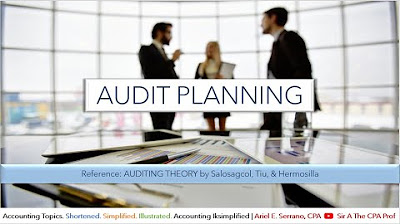4.2 Audit Procedures
Summary
TLDRThis lecture delves into audit procedures, emphasizing the auditor's role in selecting methods to gather evidence for financial statement assertions. It distinguishes between risk assessment procedures, tests of controls, and substantive tests, highlighting the importance of substantive procedures in detecting material misstatements. The script also covers various audit techniques, such as confirmations, analytical procedures, and the auditing of accounting estimates, providing insights into the auditor's toolkit for evaluating financial data.
Takeaways
- 📚 The scope of an audit refers to the audit procedures deemed necessary to achieve the objective of an audit, giving auditors the freedom to choose any procedures they determine are necessary.
- 🔎 Audit procedures are methods used by auditors to gather evidence to determine the validity of financial statement assertions, starting with assertions, leading to objectives, and then to the procedures performed.
- 🔍 Risk assessment procedures (WP) and further audit procedures (FAP), including tests of controls and substantive procedures, are crucial for understanding the entity and its environment, and for assessing the risks of material misstatement.
- 🛠️ Tests of controls assess the operating effectiveness of controls in preventing, detecting, and correcting material misstatements, while substantive procedures (test of assertions) are required to detect actual material misstatements.
- 📈 Substantive tests can be categorized into tests of details (transactions or balances) and substantive analytical procedures (SAP), with the former being required and the latter being optional.
- 🔗 The difference between tests of transactions and tests of balances lies in whether the auditor is testing the debits and credits (process of individual transactions) or the ending balance (existence of account balance).
- 🌐 Audit procedures according to nature include inspection, observation, inquiry, confirmation, computation or reperformance, tracing and vouching, reconciliation, and analytical procedures.
- 💬 External confirmations involve obtaining audit evidence from third parties through representations or information about specific items affecting financial statement assertions, with positive and negative confirmation being the two general categories.
- 📊 Substantive analytical procedures involve studying and comparing relationships among accounting data and related information to identify unusual fluctuations, with the predictability of relationships being a key factor in their effectiveness.
- 🔮 Accounting estimates, such as allowances for doubtful accounts or inventory obsolescence, carry inherent risks due to their approximation nature, and testing these estimates involves understanding management's process, developing independent expectations, and reviewing subsequent events or transactions.
Q & A
What is the primary purpose of audit procedures?
-The primary purpose of audit procedures is for the auditor to gather evidence to determine the validity of the financial statement assertions.
Why is the scope of an audit important?
-The scope of an audit is important because it refers to the audit procedures deemed necessary in the circumstances to achieve the objective of an audit, allowing the auditor to give a positive conclusion and reasonable assurance.
What are the two main categories of audit procedures according to purpose?
-The two main categories of audit procedures according to purpose are risk assessment procedures (WP) and further audit procedures (FAP), which includes tests of controls and substantive procedures.
What is the difference between test of controls and substantive tests?
-Test of controls assess the operating effectiveness of the controls in preventing, detecting, and correcting material misstatements, while substantive tests (both tests of details and analytical procedures) are designed to detect material misstatements at the assertion level.
Why are substantive procedures required to be performed in every audit?
-Substantive procedures are required to be performed in every audit because they are essential in detecting material misstatements in the financial statements, which is the core objective of the audit.
What are the two general categories of substantive tests?
-The two general categories of substantive tests are tests of details and substantive analytical procedures (SAP).
What is the main difference between inspection and observation as audit procedures?
-Inspection involves examining records, documents, or tangible assets, while observation consists of watching a process or procedure being performed by others.
What is the significance of external confirmations in an audit?
-External confirmations are significant as they provide audit evidence directly from third parties, which helps in corroborating information contained in the accounting records and related disclosures.
What are the general rules for the predictability of relationships when using substantive analytical procedures?
-Relationships in stable environments and involving income statement accounts tend to be more predictable than those in unstable environments or involving balance sheet accounts. Additionally, relationships involving transactions subject to management discretion may be less predictable.
How do auditors test accounting estimates?
-Auditors test accounting estimates by understanding how management develops the estimates, testing the process used by management, developing an independent expectation, and reviewing subsequent events or transactions.
What are some examples of common financial statement estimates that auditors might encounter?
-Examples of common financial statement estimates include allowance for doubtful accounts, inventory obsolescence, depreciation, deferred taxes, provisions for losses, and warranty claims.
Outlines

Cette section est réservée aux utilisateurs payants. Améliorez votre compte pour accéder à cette section.
Améliorer maintenantMindmap

Cette section est réservée aux utilisateurs payants. Améliorez votre compte pour accéder à cette section.
Améliorer maintenantKeywords

Cette section est réservée aux utilisateurs payants. Améliorez votre compte pour accéder à cette section.
Améliorer maintenantHighlights

Cette section est réservée aux utilisateurs payants. Améliorez votre compte pour accéder à cette section.
Améliorer maintenantTranscripts

Cette section est réservée aux utilisateurs payants. Améliorez votre compte pour accéder à cette section.
Améliorer maintenantVoir Plus de Vidéos Connexes

Audit Planning | Understanding the Entity and its Environment | Hermosilla, Tiu, Salosagcol

Tugas Presentasi Standar Audit 315 oleh Maratun Soleha, Mega Suhartini, dan Sri Riyani

4.1 Audit Objectives

Audit Risk

Tanggungjawab auditor, asersi dan tujuan audit

Mastering Going Concern Review | ACCA_F8: Essential Strategies for Exam Success •@financeskul
5.0 / 5 (0 votes)
